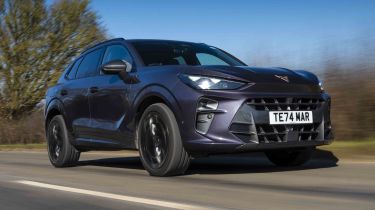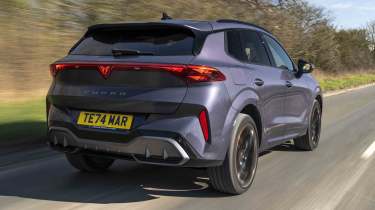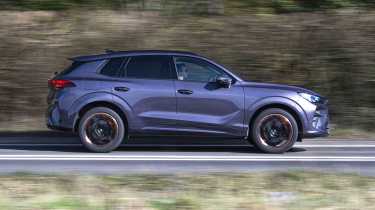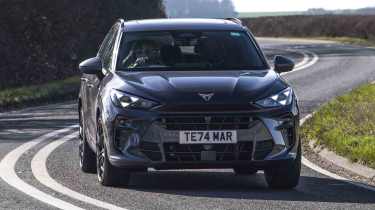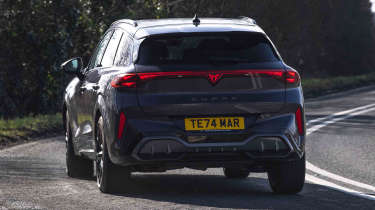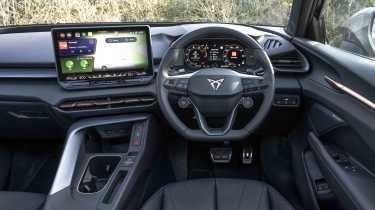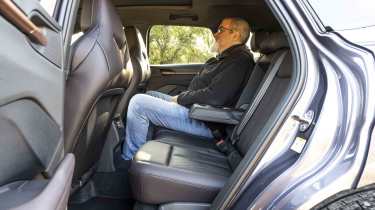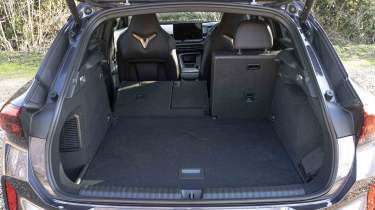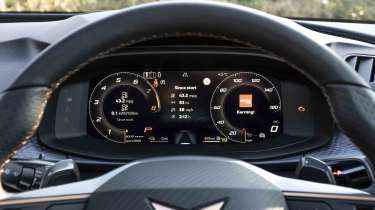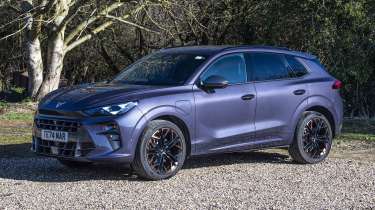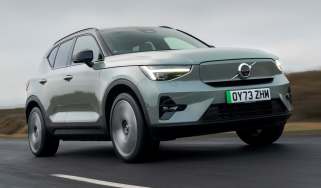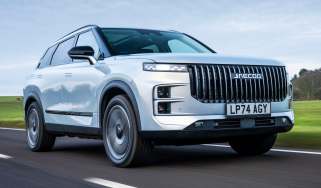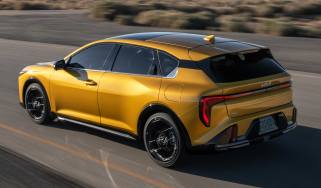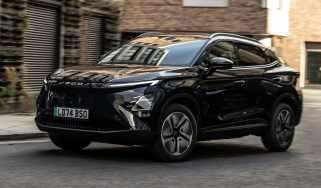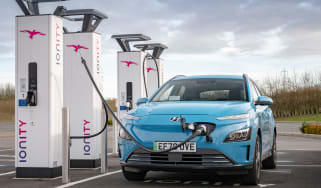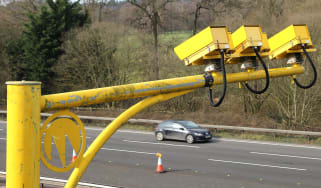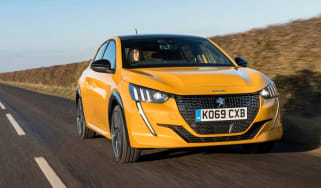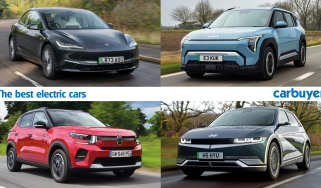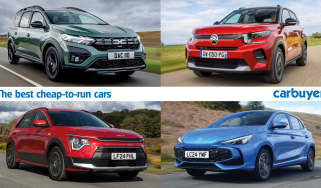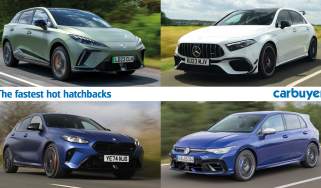Cupra Terramar review – sporty yet sensible family SUV
“The Cupra Terramar is a mid-size SUV that deftly combines the company’s sporting intent with a very practical, roomy cabin”
Pros
- Lots of neat details
- Distinctive looks
- Fun to drive and efficient
Cons
- Pricier than some rivals
- PHEV feels slow when not charged
- Boot is on the small side
Verdict – is the Cupra Terramar a good car?
The mid-size family SUV sector is hardly short on options, so you might think the Cupra Terramar has a job on its hands to stand out from the crowd. Bold, distinctive looks get the Cupra off to a great start and there are loads of neat touches that add to the sense of this being an impressive choice. Inside, there’s yet more clever styling that lends the right mix of sporty and practical that Cupra is aiming for. A range of petrol and plug-in hybrid engines, plus two- and four-wheel drive, provides buyers with lots of choice, and the Terramar balances comfort and nimble handling exceedingly well.
Cupra Terramar models, specs and alternatives
Cupra now boasts a rather wide range of models across its lineup, and one of the latest is this: a sporty mid-size SUV called the Terramar, which sits above the smaller Formentor. It’s set to eventually replace the Cupra Ateca SUV, although for the time being both are being sold alongside each other. Unlike the Ateca, though, there’s no SEAT equivalent.
The Terramar picks a path between the slightly cheaper Volkswagen Tiguan and the Audi Q3 that perhaps has an even more premium image – and the next Q3 will share the same mechanical bits as the Cupra and VW underneath.
More reviews
In-depth reviews
To distinguish the Terramar from its cousins, Cupra has done a great job with this SUV’s styling. It might not be to all tastes, but anyone who already likes Cupra’s sense of style will be lured in with the Terramar. It has the right mix of sporty looks and SUV stance that many buyers are after with this type of car, and the Cupra backs it up with the way it feels inside and how it drives.
There’s plenty of room in the front and rear for passengers, while the boot is decent though not massive for this class. You also have to remember the boot can be extended by sliding the rear bench forward, though the hybrid models’ battery does pinch a little load space.
Those hybrid models will appeal to company car drivers thanks to their low carbon dioxide emissions and excellent fuel economy. You will need to keep the battery topped up with electricity to see the most efficient consumption numbers – let it drain down and the 1.5-litre petrol motor returns very average fuel numbers and performance takes a noticeable dive as it has to lug the weight of the batteries around. With the battery charged up, the e-Hybrid models deliver peppy performance and more than fulfil the sporty SUV brief.
The entry-point 1.5-litre petrol motor is a more modest proposition, though it works well and is fine around town. We reckon the 2.0-litre turbo petrol is a more engaging option for keen drivers – the sort Cupra wants to attract – and you get four-wheel drive with this engine. However, you also get the least impressive economy and emissions. Factor in that most Terramars invoke the expensive luxury car supplement for VED (road tax) and it could be an expensive car to run for private owners.
Some will be prepared to overlook this for the way the Terramar drives, which is markedly more sharp than most in this sector. It zips through corners with no fuss and is just as happy on the motorway or around town. The ride is firmer than most in the class, but not jarringly so.
Upper trim levels come with selectable modes for the suspension, so you will need to seek out the VZ2 if this is a vital consideration. The range starts with the V1, which is very well equipped, while the V2 adds some luxuries like the Dinamica upholstery and driver’s head-up display. The VZ1 and VZ2 specs mirror the V1 and V2, while the America’s Cup Edition and First Edition trims enjoy a panoramic sunroof. All Terramars have climate control, lots of safety tech, and an automatic gearbox as standard.
| Trim levels | Power options |
|
|
MPG, running costs & CO2 emissions
| Pros | Cons |
|
|
Cupra has hedged its bets with the Terramar’s power options, so you can pick a 1.5-litre petrol with mild hybrid assistance or as a plug-in hybrid. There’s also a 2.0-litre petrol engine that has no electrical helping hand, which does unfortunately mean mediocre economy and rather high carbon dioxide emissions.
Should you be tempted by the performance of the 2.0-litre engine, the 201bhp version delivers a best claimed economy of 37.7mpg, while the zippier 261bhp model trails with 33.6mpg. Compare that to the fastest Terramar model with the 1.5 e-Hybrid plug-in powertrain with either 201- or 268bhp that deliver a claimed 706.2mpg and you would have to be seriously committed to not choosing a hybrid to go for the 2.0-litre motor.
In daily driving, you do need to keep the e-Hybrid models’ battery charged up to see anywhere near those three-digit fuel economy figures. Do this and you could easily spend most of your daily driving on EV power alone thanks to a maximum claimed electric range of between 71- and 74 miles from the 25.8kWh battery.
| Model | Fuel economy | CO2 emissions |
| 1.5 eTSI 150 | 46.3mpg | 139g/km |
| 2.0 TSI 204 4Drive | 37.7mpg | 172g/km |
| 1.5 e-HYBRID 204 | 706.2mpg | 10g/km |
| 2.0 TSI 265 4Drive | 33.6mpg | 191g/km |
| 1.5 e-HYBRID 272 | 706.2mpg | 10g/km |
How much will the Cupra Terramar cost in tax?
With the changes to Vehicle Excise Duty, or road tax as most of us know it, from April 1st 2025, most cars are now more expensive to tax even if they emit very little carbon dioxide. As a result, the 1.5 e-Hybrid models of the Cupra Terramar are liable for £110 for the first 12 months of this duty thanks to their 10g/km CO2 output. After that, they revert to the standard charge applied to most cars when they reach their first anniversary since registration.
The 1.5 eTSI engine in the Terramar emits 139g/km, so there’s a £540 bill for the initial year of road tax, but that’s a snip compared to the £2,190 for the 2.0 TSI 204 model. Yet the 2.0 265’s 191g/km sees it slip one tax bracket higher up the scale to demand a £3,300 first-year road tax bill. That is going to be painful on the purse, but first-year VED is at least factored into the purchase price of the car, so only cash buyers will need to pay the total amount upfront.
On top of all that, only the most basic Terramar V1 1.5 eTSI model has a list price of less than £40,000 to avoid the expensive car additional charge. Every other Terramar in Cupra’s range will have to pay an extra payment on top of the road tax each year until the car passes its fifth birthday.
Company car drivers will almost certainly gravitate to the 1.5 e-Hybrid models of the Terramar for their significantly lower Benefit in Kind ratings.
What will the Cupra Terramar cost to insure?
You might think the Terramar is going to cost a pretty penny to insure with its sporty looks and image. However, stick to the least expensive model and it sits in group 21 (out of 50) for insurance cover. As you’d expect, picking one of the more powerful versions will push up the group ranking for cover, so the 2.0 TSI models sit in groups 28 and 29 for the 204 and 265 versions, respectively. The 1.5 e-Hybrid resides further up the scale in groups 32 and 33 for the 204 and 272 models in turn.
All Cupra Terramars come with a long list of safety and security features to make them decently friendly for insurance purposes. Every model gets an alarm, keyless entry, and a wide range of safety kit.
Engines, drive & performance
| Pros | Cons |
|
|
Cupra has long stood for cars with a sporting edge to the way they drive, going all the way back to when the badge was still a SEAT name rather than a standalone brand. With the Terramar, Cupra has to appeal to drivers who want that dynamic ability yet also need a car capable of carting the kids to school and clubs, packing in the holiday luggage, and dealing with everyday work duties. A tough ask, but one the Terramar answers very ably.
From the moment you set off in the Terramar, it feels keener and more alert than most other SUVs in this class. Much of that is down to the ride, which is certainly firmer than you’ll find in a Volkswagen Tiguan, Mazda CX-5 or even a Ford Kuga. It lets the Terramar scoot round corners with little lean of the body on the suspension and decent steering feel. Let’s be clear, it’s not the same interaction as you get with an out-and-out sports car or hot hatch, but it definitely makes you feel like you’re in something fun.
With the VZ2 model, there is a standard Dynamic Chassis Control system with adaptive dampers. This fancy title means you can choose between 15 settings for the suspension and how stiff it is. Go for the most extreme set-up and the Terramar delivers a convincingly athletic drive, though you will feel the suspension errs very much on the firm side. Stick with something more in the middle and the Cupra offers a good balance of nimble and comfortable. You can also pick from different drive modes – Comfort, Race or Cupra – to give a different feel to the steering, gearbox and throttle responses.
Whether the Cupra Terramar you select has the adaptive damping or not, this SUV is very able at separating out any nasties from the road surface from the cabin. In town, potholes are nothing to worry about and the Cupra’s steering is light, so you can dodge round them with ease and parking is also simple. Front and rear parking sensors are included with all Terramars, but you need to look to the V2 trim for the excellent top-view camera to help with slotting the car into tighter bays.
Take the Terramar on to more flowing roads and it’s in its element. You do feel the added weight of the hybrid models when cornering, so the Cupra is a car best enjoyed with a smooth driving style. Treat it like a hot hatch and it quickly lets you know this is not the best way with the front tyres scrabbling for grip. However, by SUV standards, the Terramar is entertaining and able.
Even on the motorway, the Cupra imparts the notion of a little more engagement with the driver. You sense the Terramar can deal with sudden change of direction, such as when a car in front unexpectedly changes lane or a hazard appears. All this and the Terramar also delivers very good refinement thanks to little engine, wind or road noise, and the automatic gearbox that’s standard across the line-up slips between gears noiselessly and smoothly.
Petrol models
You might be tempted to discount the 1.5 eTSI 150 engine in the Cupra Terramar. This is, after all, an SUV with sporty ambitions. Yet, if outright acceleration is not vitally important to you, this engine delivers a respectable account of itself with 0-62mph in 9.3 seconds, so it’s not exactly dragging its heels. Where you might find this motor a little disappointing is when you want to overtake slower traffic. It will do this, and the DSG twin-clutch automatic gearbox drops down a gear or two very quickly to help, but there isn’t quite the muscle to pass as swiftly as we’d like.
This is where the 2.0-litre turbo petrol engines come into play with their deeper reserves of power – even if they do come with a fuel economy and emissions penalty that will put off most buyers. This engine has acceleration to match hot hatches and works well, helped by its standard four-wheel drive that delivers unflappable grip in corners. However, it’s the 265 model that gives the Terramar the chops to qualify as a performance SUV. From rest to 62mph takes only 5.9 seconds, so it can keep pace with the best of the hot hatch brigade yet also cruise in town or on the motorway in a relaxed manner. Again, it also has all-wheel drive to make sure that power is delivered in the form of forward motion rather than the wheels spinning uselessly.
| Model | Power | 0-62mph | Top speed |
| 1.5 eTSI 150 auto | 148bhp | 9.3s | 127mph |
| 2.0 TSI 204 auto 4Drive | 201bhp | 7.1s | 140mph |
| 2.0 TSI 265 auto 4Drive | 261bhp | 5.9s | 151mph |
Hybrid models
There are undoubted benefits to choosing either of the 1.5 e-Hybrid engines in the Cupra Terramar. Low running costs, excellent economy and company driver-friendly numbers. When it comes to their on-road manners, however, these two engines don’t enjoy such an advantage. This is down to their battery packs, which add weight that makes itself felt during cornering and when the electricity level is not sufficient to help with acceleration.
Should you let the battery drop too low on charge, there’s no hybrid assistance to help out and nor does the Terramar recharge while it’s driving. That means you need to connect it to a charge point on a regular basis to get the best from the car. And even with a full charge, the most powerful 272 model – the most potent Terramar model of them all – covers 0-62mph in 7.3 seconds, which is some way short of the 2.0-litre TSI 265 version. Take the lower power e-Hybrid and 0-62mph takes a second longer.
That wouldn’t stop us from choosing either of these engines in the Terramar, though it might make us enjoy the car slightly less when a clear country road presents itself. However, the ability to cover more than 70 miles on electric power alone does mean you can cover most journeys without using a drop of petrol.
| Model | Power | 0-62mph | Top speed |
| 1.5 e-HYBRID 204 auto | 201bhp | 8.3s | 127mph |
| 1.5 e-HYBRID 272 auto | 268bhp | 7.3s | 134mph |
Interior & comfort
| Pros | Cons |
|
|
Is the Cupra Terramar infotainment and sat-nav system easy to use?
The 12.9-inch infotainment touchscreen in the Terramar is the same as those found in Cupra’s other models. It has a large display, set in a landscape orientation, so it’s easy to see from the driver’s seat or the passenger side of the front cabin. Handily, there are permanently displayed icons along the top and bottom of the display to save you diving in and out of menus to find what you need. The bottom row is for the climate control, though you still get the slightly finicky sliding controllers below the touchscreen to adjust the temperature.
Every Terramar uses this 12.9-inch monitor and all come with Apple CarPlay and Android Auto to connect to your phone. There’s also a wireless phone charger so you can listen to your music or podcasts for as long as you like without running the phone battery down. You get a pair of USB-C charge sockets in the front and another two for rear seat passengers.
You can also operate the infotainment screen using voice control, which keeps your hands on the steering wheel. It’s as easy as any of these systems and responds to most simple commands quickly.
Higher spec versions of the Terramar – from V2 upwards – have a driver’s head-up display. This is in addition to the 10.25-inch digital cockpit display that acts as the main instrumentation. It gives a clear and crisp view of speed, revs and other vital info and can be configured with different displays in V2 trim and above.
Key features | |
|
V1
|
V2 (V1 plus…)
|
|
VZ1 (V1 plus…)
|
VZ2 (VZ1 plus…)
|
|
VZ First Edition (VZ2 plus…)
|
America’s Cup Edition (VZ2 plus…)
|
Boot space, practicality & dimensions
| Pros | Cons |
|
|
Cars with sporting intentions often leave practicality and space on the back burner, but not the Cupra Terramar. As an SUV, it’s off to a decent start, especially as it shares its platform with the Volkswagen Tiguan. The VW is a little longer and roomier for occupants and luggage, but you’re not going to struggle to fit everyone into the Cupra.
Sculpted front sports seats in the Terramar look good and offer excellent support on longer journeys. They also adjust easily and you can move the steering wheel for angle and depth to find the ideal driving position. You don’t sit as high up as in some other SUVs, notably the likes of the Subaru Forester or Land Rover Discovery Sport, but the Cupra offers good vision in most directions. However, the rear view either in the mirror or when you glance over your shoulder is inhibited by the rear seat’s headrests. All Terramars come with front and rear parking sensors, and the V2 and above trims have the excellent top-view camera, to help in packed car parks.
Those in the front have a pair of cupholders to pick from, one small and one large which helps when you just want an espresso rather than a big gulp of water. You’ll find the wireless charging pad at the front of the central console and there’s also a cubby under the centre armrest. Doors bins that are a decent size and shape are welcome, while the glovebox can hold a phone and sunglasses case.
The rear doors open wide enough to make fitting a child seat simple and there are ISOFIX mounts in the two outer chairs to secure child car seats. Older kids will find plenty of head and leg room, and there’s enough width to the Terramar to accommodate three children across the bench. Adults might find that a little snug, but they still get sufficient space for their heads, legs, knees and shoulders with two sat in the back.
One neat touch for the rear of the Terramar is Cupra has repeated the front LED lights set into the doors are repeated in the back, which looks good and illuminates the cabin very well.
| Size comparison | |||
| Model | Length | Width | Height |
| Cupra Terramar | 4519mm | 1863mm | 1584mm |
| Alfa Romeo Tonale | 4528mm | 1841mm | 1612mm |
| BMW X2 | 4554mm | 1845mm | 1590mm |
| Volkswagen Tiguan | 4539mm | 1842mm | 1658mm |
Does the Cupra Terramar have a big boot?
At 540-litres, the Cupra Terramar’s boot is among the larger cargo spaces in this part of the SUV sector. It is worth pointing out the hybrid models have their boot capacity reduced to between 400- and 490-litres depending on model to cope with their battery packs. It’s not a disaster as the boot remains a regular shape and the load sill is not as high as in some SUVs. Even so, the Terramar does trail the Volkswagen Tiguan’s more than generous 652-litre boot capacity by some margin.
Cupra does its best to make up for this by placing the boot floor level with the load sill so you just slide heavier items in and out. There are also load securing points and larger items can be accommodated by folding down one or more of the 40:20:40 split and tumble rear seats. Do this and you will need to find somewhere to keep the one-piece parcel shelf – it would have been better if this was the retractable load cover type.
Should you want to go further with the Terramar’s carrying abilities, it can tow a braked trailer of between 1,800- and 2,200kg depending on the model, with the hybrids at the lower end of that scale. You can order a tow bar from Cupra’s options list when buying a Terramar new.
| Boot space comparison | |
| Model | Boot space |
| Cupra Terramar | 540l |
| Alfa Romeo Tonale | 500-1,550l |
| BMW X2 | 515-1,400l |
| Volkswagen Tiguan | 652-1,650l |
Reliability & safety
| Pros | Cons |
|
|
Cupra has set itself apart from other members of the Volkswagen family with its five-year, 90,000-mile warranty. While that’s not quite as generous as the seven-year/100,000-mile cover from Kia, it still offers a big slice of peace of mind. As well as this, the e-Hybrid models also come with an eight-year, 100,000 separate battery warranty.
If you want to put your mind at rest even more, Cupra offers a three-year servicing deal under its Cupra Care banner with fixed monthly payments for routine servicing.
Cupra came a decent 18th out of 32 car makers in our most recent Driver Power satisfaction survey, which was ahead of sister company SEAT that finished in 24th spot.
How safe is the Cupra Terramar?
The Cupra Terramar was crash-tested by Euro NCAP in April 2025 and it achieved the full five-star rating. Its highest scores were in the adult occupant and child occupant protection categories, where it was awarded 89% and 87%, respectively. It was also awarded 82% for vulnerable road user protection, while it achieved 76% for its comprehensive suite of safety assistance tech.
All models come with the full set of mandatory safety features, including autonomous emergency braking that also works when reversing, lane assist, traction control, blind spot monitoring, and traffic sign recognition. You also get adaptive cruise control and a rear-view camera.
Choose the V2 trim or higher and the Terramar gains a head-up display for the driver, along with high beam assistance, advanced lane assist, traffic jam assist, side and exit assist, and rear traffic assistance. These models also have Cupra’s pre-crash system to tighten the seat belts, close the windows, and activate the hazard lights if it senses an imminent collision.
Should you buy a Cupra Terramar?
With no fewer than four SUVs in its line-up with the arrival of the Terramar, you may wonder why Cupra needed another. Part of the reason is the Terramar will, in time, replace the ageing Ateca and the new car brings with it plug-in hybrid power with an EV driving range of up to 76 miles – not be sniffed at.
The more traditional power options for the Terramar – 1.5 eTSI and 2.0-litre TSI petrols – hold some appeal. Choose the smaller engine and it’s cheaper than the rest of the range to buy, while the larger motor brings four-wheel drive to the party. These varying factors will appeal to some, but others will want the low emissions and impressive on-paper fuel economy of the hybrids – notably company drivers looking to keep their tax bills as low as possible. Private buyers might be more circumspect when most Terramars tip over the £40,000 new car price threshold and so incur the additional luxury car road tax levy for the first five renewal years. Add that to the high road tax bands of the 2.0-litre models and these Cupras begin to look punitively pricey.
If you can make the sums add up in your favour, the Cupra Terramar is a hugely likeable and capable mid-sized SUV. It does all of the family SUV bits very capably as it has a roomy cabin, excellent build quality, decent boot, and strong warranty. It’s also more fun to drive than most other SUVs in this class, and don’t underestimate that when you have to live with a car for thousands of miles. You’ll also find it comfortable, refined, and well equipped.
In achieving all of this, Cupra has made the Terramar a slightly less focused and exciting car than the Tavascan or Formentor. However, that’s the price to be paid for competing with a broad, and broadly talented, selection of rivals vying for buyers’ attention.
What is the best Cupra Terramar for low running costs?
This is a straight fight between the 1.5 eTSI and 1.5 e-Hybrid versions of the Cupra Terramar. For private buyers, the petrol-only 1.5 e-TSI is hard to dismiss as it costs £6,500 less than the plug-in hybrid 1.5 e-Hybrid. However, company drivers will likely be better off with the PHEV for its 10g/km CO2 emissions and the impact that has on the tax they’ll pay.
What is the best Cupra Terramar for keen drivers?
The 268bhp 1.5 e-Hybrid 272 may be the most powerful Cupra Terramar but it’s not the quickest. That accolade goes to the 2.0 TSI 265 4 Drive model that sees off 0-62mph in 5.9 seconds, tops 150mph flat out, and comes with four-wheel drive. It also feels more agile and engaging to drive.
What is the Carbuyer pick of the Cupra Terramar range?
It might sound counterintuitive to choose the slowest model from a sporty SUV’s line-up, but we’d take the Cupra Terramar 1.5 eTSI 150. This version might take a little longer to go from 0-62mph on paper, but on the road it feels brisk and it handles with panache. It’s also a good deal more affordable than some Terramar models, which can stray towards being surprisingly expensive, while dishing up reasonable running costs.
Cupra Terramar alternatives
If we were to reel off every rival to the Cupra Terramar in the mid-size SUV sector, we’d be here all day. And all night… We’ll keep it to the class leaders in that case, which start with the Volkswagen Tiguan that is closely related to the Terramar and shares its VW Group platform. Also from the broader VW empire is the Audi Q3 and Skoda Kodiaq for similar money. Anyone in this market also has to consider the stylish BMW X2, Honda CR-V, Mazda’s CX-5 and CX-60, and the Toyota RAV4. You should also look at the Alfa Romeo Tonale for a sportily able rival to the Cupra.
Which Is Best?
Cheapest
- Name1.5 eTSI 150 V1 5dr DSG
- Gearbox typeSemi-auto
- RRP£37,605
Most Economical
- Name1.5 eHybrid 204 V1 5dr DSG
- Gearbox typeSemi-auto
- RRP£44,055
Fastest
- Name2.0 TSI 265 VZ1 5dr DSG 4Drive
- Gearbox typeSemi-auto
- RRP£45,095
